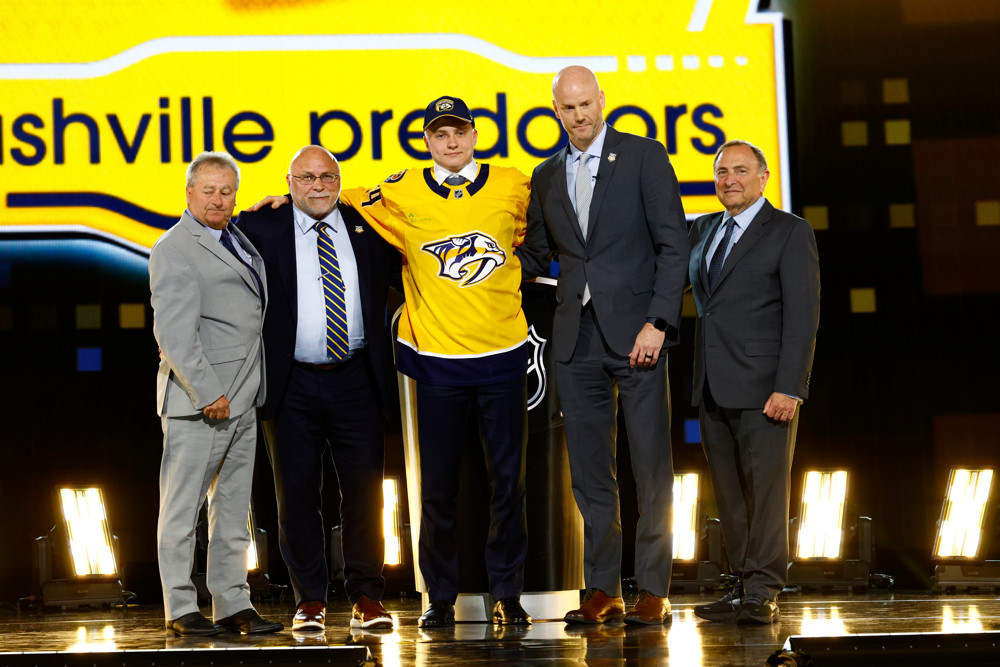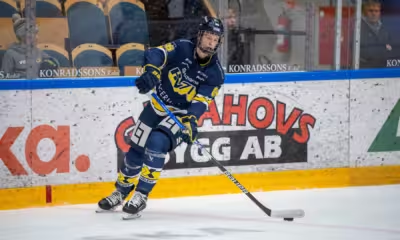The Nashville Predators added eight new prospects to the pipeline at the 2024 NHL Draft, including four forwards with their first five picks. Each draftee brings a unique element to the organization, but Barry Trotz’s front office targeted prospects with high offensive ceilings. I dug into each prospect with some video analysis of their strengths, weaknesses, and projectability.
Egor Surin | F | Loko Yaroslavl (MHL) | 22nd overall
Despite trying to trade up in the first round of the NHL draft several times, Nashville ultimately picked at 22nd overall with several big-name forwards off the board. The Predators surprised several, taking Russian forward Egor Surin. But make no mistake, the 6’1″ prospect is a first-round talent. In 42 MHL games last season, Surin scored 22 goals and 52 points for Loko Yaroslavl; he added another 23 points in 19 playoff games.
Surin was a certified star in the MHL last season. He toyed with defenders, aggravated opponents, and scored incredible goals whenever he was on the ice. You’ve read this before, but Surin’s motor is truly the defining feature of his game. He’s constantly moving his feet, hunting the puck or finding open space to score from. As shown above, Surin attacks defenders, pushing them back on their heels and forcing them to catch him in high-danger areas. He frequently wins those battles before sliding pucks past helpless goalies.
In a league where defense is optional, Surin bucked that trend at times. He wasn’t immune to lackadaisical play in his end, but on his best shifts, he was hounding puck carriers along the wall and at the point. He forces turnovers and follows the play up, carrying the puck to lead the transition himself.
Surin’s skating and pace are good; he could probably work on his stride extensions more before reaching the NHL, but he’s quick and agile nonetheless. In transition, Surin can handle the puck well while moving at top speed. He’s decent at surveying his options and scanning the ice, but his processing speed and decision-making aren’t a recipe for success in the pros right now. What is projectable, however, is his ability to lower his shoulder and muscle around defenders off the rush; he may not always beat guys with speed, but he’ll dig down and win the play anyway.
On the forecheck, Surin can be lethal. He attacks defenders with good angles and puts legitimate pressure on those retrieving the puck. He also loves to hit opponents, adding a layer of frustration to his overwhelming style of play. When Surin’s forechecks result in giveaways, he goes after the puck almost always creating an immediate scoring chance.
In the offensive zone, Surin’s scoring touch is complemented by slick puckhandling abilities. He uses his pace and deceptive skating moves to work his way around the zone while still scanning for passing options. His playmaking isn’t always the most accurate, but he finds teammates in scoring positions often and doesn’t hesitate to crash the net himself.
So much of Surin’s game translates to the NHL. He’s a hard worker, forechecks well, can make plays at a good pace, and can score. What could hold him back is mostly just his offensive decision-making. If he can add more diversity to how he attacks with the puck, he’ll create more chances with his teammates and won’t stickhandle into a corner as often.
Teddy Stiga | W | U.S. National Team Development Program (USHL) | 55th overall
Taken with their second pick in the 2024 NHL Draft, Teddy Stiga isn’t too different from Egor Surin. The American winger stands around 5’10” and 180 pounds. In 61 games with the U.S. National Team Development Program (NTDP), Stiga scored 36 goals and 79 points, finishing third on the team behind Islanders’ pick Cole Eiserman and 2025 prospect James Hagens. In seven games at the U18 World Junior Championship (WJC), Stiga added six goals and 11 points.
A lot of folks have characterized this pick as a steal, but I think that word gets thrown around too much. Did I expect Stiga to be available at 55th overall? No, but he was always likely to be a second-round pick. Regardless, the Massachusetts native might end up being the best U.S. NTDP product from this class.
Much like Surin, Stiga is relentless in pursuit of the puck. When forechecking, he dives at defenders with an active stick, forcing them into quick decisions. He back-checks equally hard as well never missing an opportunity to reverse play in the neutral zone. Stiga is incredibly adept at turning possession around and opposing puck carriers have almost no way to stop it. When Stiga recovers the puck, he launches into give-and-go-style hockey, dishing possession to a teammate before cutting into open ice ready to receive a pass. Similarly, in transition, Stiga will start rushes at his blue line then jump into an excellent puck-support lane, layering his team’s attack and antagonizing defenders.
Despite his forechecking tenacity, Stiga maintains great positioning in all three zones. There are a few too many wide turns in his game for my like right now, but he recovers well, manning his post near the point when play is in his defensive zone. Stiga thinks the transition game so well; in fact, I’d argue his IQ with the puck is one of the best in this class. He’s constantly on top of where his teammates are and where they’re going and complements that with subtle touches, tweaks to his body position, and creative passes to spring their attack.
Stiga’s skating mechanics are good, but like Surin, his advantage is the ability to make plays at his quickest pace. He could stand to add a bit more speed and power as he develops, but his four-way agility and edge control are already excellent.
On top of all that, Stiga demonstrates a great scoring touch. His wrist and snapshots are very good and should only improve with time in college, and he needs little to no time to fire off the puck after receiving a pass or intercepting a giveaway. His stickhandling skills are excellent, and he can deceive defenders with his hands all while scanning the ice for better options.
All in all, there’s not a ton that Stiga doesn’t do well. Boston College, where he’s headed next year, will help him refine some of the wrinkles to his game and provide valuable playing time against stronger men; but Stiga is shaping up to be a significant top-six scoring threat in the NHL one day.
Miguel Marques | W | Lethbridge Hurricanes (WHL) | 87th overall
Continuing the trend of picking offensive firepower that can bring fans out of their seats, Nashville selected Miguel Marques in the third round of the 2024 NHL Draft. Marques is a winger who’s spent the past couple of years with the Lethbridge Hurricanes of the WHL. After a 20-point rookie season, Marques exploded to score 28 goals and 74 points in 67 games for the Hurricanes last year (enough to lead the team).
Marques is the definition of a boom-or-bust player. Some nights this year he looked like an AHL player at best; some nights, he looked like the best scorer in the league. Similar to Surin and Stiga, his game is defined by a nose for the net and an impressive scoring touch.
Marques is a toolsy player with good hands and a strong ability to navigate a crowded neutral zone. His puckhandling is smooth enough that he looks like he’s barely trying at times, but his moves are legitimately hard to defend against. He plays with a good understanding of attacking lanes, knowing where to position himself off the puck to pick up a rush chance when the opportunity presents itself. On top of that, his finishing ability is up there with the best in this NHL draft class.
Marques, sometimes through necessity, is patient with the puck. Whereas Teddy Stiga will use a quick manipulation of his stick blade to spring a teammate, Marques has the ability (and tendency) to slow the play down. He’ll draw forecheckers into his orbit with delay tactics, opening space for him to lead the rush once he stickhandles around them. That of course won’t always work at higher levels, but he’s shown enough creativity with the puck to be an impactful playmaker.
The Lethbridge winger is by no means slow; he’s a fine skater at the junior level. But his puck skills risk being compromised in the pros without improving his mechanics. He leverages lateral crossovers well to navigate opponents when carrying the puck, but his accelerating steps aren’t particularly explosive, and his stride extensions are often a bit stunted.
While Marques’ defensive game isn’t particularly detail-oriented, he does show a good understanding of off-puck positioning. In his end, he’s usually in a good spot to launch an attack with give-and-go passing; in the offensive zone, he finds open ice to receive passes or jump on loose pucks.
And again, when he gets the puck, defenders can’t help but reach into his wheelhouse as he fires off cross-ice passes to set up teammates.
In the offensive zone, Marques isn’t afraid of the middle of the ice, and I think he’s got a decent physical edge to him too. He can dish the puck from wherever though, displaying excellent vision to exploit the smallest of seams he’s given. And whether you give him those small spaces or a ton of open ice, he’s a serious threat to beat goalies with his shooting skill as shown above.
Despite a long road to an NHL future, I like the upside Nashville bet on in taking Marques. I don’t think he’ll score 40 goals in the pros, but I do think he could become a decent middle-six playmaker if everything goes right.
Hiroki Gojsic | W | Kelowna Rockets (WHL) | 94th overall
It’s easy to see why the Nashville Predators drafted Hiroki Gojsic 94th overall. He’s 6’3″, 200 pounds, and has an NHL-ready shot. After a year in the BCHL, Gojsic joined the WHL’s Kelowna Rocks in 2023-24 and scored 21 goals and 50 points in 68 games—good for fifth on the team.
Gosjic’s game is defined by his big frame barreling down the ice, with or without the puck, making life easier for his teammates. Playing big minutes with Andrew Cristall and Tij Iginla this season, Gojsic showed his ability to play off the puck, pushing defenders back, giving his teammates a solid passing option, and more. The British Columbia native forechecks hard, making life difficult for puck-retrieving defenders with an active stick and a physical presence. While Gojsic could improve his takeaway efforts, he’s solid at forcing giveaways.
Gojsic showed fine puckhandling skills in the WHL this year. He’s got decent vision and can make his way up the ice, maintaining possession against serious challenges, but his hands will probably grade out as NHL average. While he can move through the neutral zone with the puck well, Gojsic’s skating speed is a step behind, and he frequently devolves into a glide when he’s ready to make a play. As a result, many shifts ended with him getting forced to the perimeter of the offensive zone, launching low-danger wrist shots instead of utilizing delay tactics with the puck.
Despite those limitations, Gojsic plays an important role in the offensive zone. Even if his rush gets stifled or if he has to offload possession to a teammate, he’s valuable in front of the net—winning most puck battles and putting tons of high-danger shots on-net.
When Gosjic plays a supporting role off the rush, he’ll bully his way to the middle of the ice, doing his best to get open but having the reach to make his own opportunities too. It’s those moments where Gojsic can display his threatening wrist shot that led to an impressive 20+ goals in his rookie WHL season.
I also think Gojsic doesn’t get enough credit for his defensive zone. While his footspeed isn’t always there, his instincts are. He mans the blue line well, keeping his head on a swivel, and catching opponents sneaking down to the back door.
The best-case scenario Nashville is hoping for with Gojsic is that he grows into a Yakov Trenin- or Colton Sissons-type bottom-six player. While that may be more unlikely than not, you can see those foundations in his game so far.

















